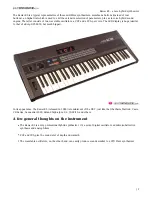
38
Subject to change without notice
O p e r a t i n g c o n t r o l s
POWER
Commands in order to change the level of the RF output si-
gnal
Syntax:
:POWer[:LEVel]
<
NUM
>
(1)
:POWer[:LEVel]?
(2)
:POWer:UNIT V | DBM
(3)
:POWer:UNIT?
(4)
Sending line (1) modifi es the level. The
<
NUM
>
parameter is a
NR2 number (see paragraph Syntax conventions). No unit has
to follow the number, the current unit is assumed. Sending line
(2) the instrument returns the current level. The instruments
sends back a NR2 number corresponding to the resolution
without the unit.
Sending line (3) changes the current unit. Two parameters
are possible: V for Volt (mV / μV included) or DBM for dBm.
Sending line (4) the instruments returns the current unit. The
instruments sends back the same string as the corresponding
command parameters above (e.g. DBM).
Examples:
:POW:UNIT DBM
Set the level unit dBm
:POWER:UNIT DBM
Set the level unit dBm
:POW 5.7
Set the level to 5.7 dBm
:POW:LEV 5.7
Set the level to 5.7 dBm
:POWER:UNIT?
Request for unit
FREQUENCY
Commands in order to change the frequency
Syntax:
:FREQuency[:CW|:FIXed]
<
NUM
>
(1)
:FREQuency[:CW|:FIXed]?
(2)
Sending line (1) modifi es the carrier frequency. The
<
NUM
>
pa-
rameter is a NR1 or NR2 or NR3 number (see paragraph Syntax
conventions). No unit has to follow the number, the Hz unit is the
default one. The value is rounded (same as the keypad) to the
resolution. The CW and FIXed options have no particular effect on
the instrument, they are present for compatibility with programs
existing in the SCPI standard. Sending line (2) the instrument
returns the current (carrier) frequency. The instrument sends
back a string representing a NR3 decimal number.
Examples:
:FREQ 678E+6
Setting of the frequency to 678 MHz
:FREQUENCY 34000000 Setting of the frequency to 34 MHz
:FREQ? Request
for
frequency
:FREQ:FIX 900E+6
Setting of the frequency to 900 MHz
PHASE
Commands in order to select the source of the reference
signal
Syntax:
:PHASe:SOURce INTern | EXTern
(1)
:PHASe:SOURce?
(2)
Sending line (1) the current reference can be selected. Only
one of the 2 parameters must be present: INTern for turning
the internal reference on or EXTern for turning the external
reference on.
STOP
Note:
It is strongly advised to check the current state
after the command (1) sent. For example with the
query command (2).
Sending line (2) the instruments returns which source is cur-
rently selected. The instrument sends back the strings INT or
EXT corresponding to the 2 options described above.
Examples:
:PHAS:SOURCE EXT
Activating the external reference
:PHASE:SOUR?
Request for current reference
:PHAS:SOUR?
Request for current reference
(abbreviated
form)
PULM (PULse Modulation)
Commands in order to modify the GATE modulation.
Syntax:
:PULM:STATe 1 | ON | 0 | OFF
(1)
:PULM:STATe?
(2)
Sending line (1) the GATE modulation can be activated or deac-
tivated. The parameters 1 or ON turn the modulation on and
0 or OFF turn the modulation off (if present). Sending line (2)
the instruments returns the state of the GATE modulation. The
instrument sends back 0, if the modulation is switched off, and
1, if the modulation is online.
:PULM:POLarity NORMal | INVert
(3)
:PULM:POLarity?
(4)
Sending line (3) the validation level of the GATE modulation can
be set. The parameter NORMal represents high level validation
and INVert represents low level validation.
Sending line (4) the instrument returns the current level state.
The instrument sends back 1 for high level (NORMal) and 0 for
low level (INVert).
AM (Amplitude Modulation)
Commands in order to modify AM parameters
Syntax:
:AM[:DEPTh]
<
NUM
>
(1)
:AM[:DEPTh]?
(2)
Sending line (1) the modulation depth can be modifi ed. The
<
NUM
>
parameter is a NR2 number (see paragraph Syntax
conventions). No unit has to follow the number, % unit is the
default one. If the value has an accuracy higher than the reso-
lution (0.1%), the number is rounded to the resolution. Sending
line (2) the instrument returns the current depth of modulation.
The instruments sends back a NR2 number corresponding to
the resolution (one digit after the decimal point) without unit.
:AM:SOURce INTern | EXTern
(3)
:AM:SOURce?
(4)
Sending line (3) the modulation source can be selected and the
FM will be turned on. Sending line (4) the instrument returns
the source modulation. The instrument sends back the strings
INT or EXT (not INTERN or EXTERN). If the AM is turned off, the
string INT is sent back because this source is the default setting
for the command AM:STAT 1 .
:AM:INTern:FREQuency
<
NUM
>
(5)
:AM:INTern:FREQuency?
(6)
Sending line (5) the frequency of the internal modulation signal
can be changed. The
<
NUM
>
parameter is a NR1 or NR2 or
NR3 number (see paragraph Syntax conventions). No unit has
to follow the number, Hz unit is the default one. The value is
rounded to the resolution.
Содержание HM8135-X
Страница 2: ......
Страница 3: ...3 G H z R F S y n t h e s i z e r H M 8 1 3 5 Handbuch Manual Deutsch English...
Страница 44: ...42 Subject to change without notice Phi Phi Phi Phi F l o w C h a r t s Function selection Step control...
Страница 45: ...43 Subject to change without notice FSK PSK GATE FSK PSK GATE F l o w C h a r t s Amplitude Modulation Control...
Страница 46: ...44 Subject to change without notice FSK PSK GATE FSK PSK GATE Phase Modulation Control F l o w C h a r t s...
Страница 47: ...45 Subject to change without notice FSK PSK GATE FSK PSK GATE Frequency Modulation Control F l o w C h a r t s...
Страница 50: ...48 Subject to change without notice FSK PSK GATE FSK PSK GATE Gate Control F l o w C h a r t s...







































